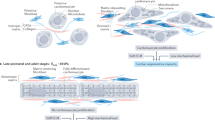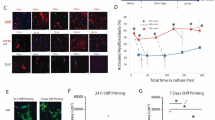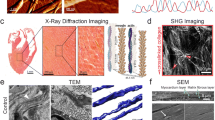Abstract
Adult cardiomyocytes are terminally differentiated with minimal replicative capacity. Therefore, long-term preservation or enhancement of cardiac function depends on structural adaptation. Myocytes interact with the extracellular matrix, fibroblasts, and vascular cells and with each other (end to end; side to side). We review the current understanding of the mechanical determinants and environmental sensing systems that modulate and regulate myocyte molecular machinery and its structural organization. We feature the design and application of engineered cellular microenvironments to demonstrate the ability of cardiac cells to remodel their cytoskeletal organization and shape, including sarcomere/myofibrillar architectural topography. Cell shape-dependent functions result from complex mechanical interactions between the cytoskeleton architecture and external conditions, be they cell–cell or cell–extracellular matrix (ECM) adhesion contact-mediated. This mechanobiological perspective forms the basis for viewing the cardiomyocyte as a mechanostructural anisotropic continuum, exhibiting constant mechanosensory-driven self-regulated adjustment of the cytoskeleton through tight interplay between its force generation activity and concurrent cytoarchitectural remodeling. The unifying framework guiding this perspective is the observation that these emerging events and properties are initiated by and respond to cytoskeletal reorganization, regulated by cell–cell and cell–ECM adhesion and its corresponding (mutually interactive) signaling machinery. It is important for future studies to elucidate how cross talk between these mechanical signals is coordinated to control myocyte structure and function. Ultimately, understanding how the highly interactive mechanical signaling can give rise to phenotypic changes is critical for targeting the underlying pathways that contribute to cardiac remodeling associated with various forms of dilated and hypertrophic myopathies, myocardial infarction, heart failure, and reverse remodeling.





Similar content being viewed by others
References
Aberle H, Butz S, Stappert J, Weissig H, Kemler R, Hoschuetzky H (1994) Assembly of the cadherin–catenin complex in vitro with recombinant proteins. J Cell Sci 107(Pt 12):3655–3663
Adams CL, Nelson WJ (1998) Cytomechanics of cadherin-mediated cell–cell adhesion. Curr Opin Cell Biol 10:572–577
Bierkamp C, McLaughlin KJ, Schwarz H, Huber O, Kemler R (1996) Embryonic heart and skin defects in mice lacking plakoglobin. Dev Biol 180:780–785
Brade T, Manner J, Kuhl M (2006) The role of Wnt signalling in cardiac development and tissue remodelling in the mature heart. Cardiovasc Res 72:198–209
Brancaccio M, Hirsch E, Notte A, Selvetella G, Lembo G, Tarone G (2006) Integrin signalling: the tug-of-war in heart hypertrophy. Cardiovasc Res 70:422–433
Bray MA, Sheehy SP, Parker KK (2008) Sarcomere alignment is regulated by myocyte shape. Cell Motil Cytoskeleton 65:641–651
Carver W, Terracio L, Borg TK (1993) Expression and accumulation of interstitial collagen in the neonatal rat heart. Anat Rec 236:511–520
Charrasse S, Meriane M, Comunale F, Blangy A, Gauthier-Rouviere C (2002) N-cadherin-dependent cell–cell contact regulates Rho GTPases and beta-catenin localization in mouse C2C12 myoblasts. J Cell Biol 158:953–965
Chopra A, Tabdanov E, Patel H, Janmey P, Kresh JY (2011) Cardiac myocyte remodeling mediated by N-cadherin-dependent mechanosensing. Am J Physiol Heart Circ Physiol (in press)
Choquet D, Felsenfeld DP, Sheetz MP (1997) Extracellular matrix rigidity causes strengthening of integrin–cytoskeleton linkages. Cell 88:39–48
Chu YS, Thomas WA, Eder O, Pincet F, Perez E, Thiery JP, Dufour S (2004) Force measurements in E-cadherin-mediated cell doublets reveal rapid adhesion strengthened by actin cytoskeleton remodeling through Rac and Cdc42. J Cell Biol 167:1183–1194
Cohn J, Anand I (2006) Overview: cardiac remodeling and its relationship to the development of heart failure. In: Greenberg B (ed) Cardiac remodeling: mechanisms and treatment. Taylor and Francis, New York, pp 1–8
Deshpande VS, McMeeking RM, Evans AG (2006) A bio-chemo-mechanical model for cell contractility. Proc Natl Acad Sci USA 103:14015–14020
Dzamba BJ, Jakab KR, Marsden M, Schwartz MA, DeSimone DW (2009) Cadherin adhesion, tissue tension, and noncanonical Wnt signaling regulate fibronectin matrix organization. Dev Cell 16:421–432
Engler AJ, Carag-Krieger C, Johnson CP, Raab M, Tang HY, Speicher DW, Sanger JW, Sanger JM, Discher DE (2008) Embryonic cardiomyocytes beat best on a matrix with heart-like elasticity: scar-like rigidity inhibits beating. J Cell Sci 121:3794–3802
Engler AJ, Griffin MA, Sen S, Bonnemann CG, Sweeney HL, Discher DE (2004) Myotubes differentiate optimally on substrates with tissue-like stiffness: pathological implications for soft or stiff microenvironments. J Cell Biol 166:877–887
Engler AJ, Sen S, Sweeney HL, Discher DE (2006) Matrix elasticity directs stem cell lineage specification. Cell 126:677–689
Fomovsky GM, Thomopoulos S, Holmes JW (2010) Contribution of extracellular matrix to the mechanical properties of the heart. J Mol Cell Cardiol 48:490–496
Friedland JC, Lee MH, Boettiger D (2009) Mechanically activated integrin switch controls alpha5beta1 function. Science 323:642–644
Ganz A, Lambert M, Saez A, Silberzan P, Buguin A, Mege RM, Ladoux B (2006) Traction forces exerted through N-cadherin contacts. Biol Cell 98:721–730
Gavard J, Lambert M, Grosheva I, Marthiens V, Irinopoulou T, Riou JF, Bershadsky A, Mege RM (2004) Lamellipodium extension and cadherin adhesion: two cell responses to cadherin activation relying on distinct signalling pathways. J Cell Sci 117:257–270
Gavard J, Marthiens V, Monnet C, Lambert M, Mege RM (2004) N-cadherin activation substitutes for the cell contact control in cell cycle arrest and myogenic differentiation: involvement of p120 and beta-catenin. J Biol Chem 279:36795–36802
Gerdes AM, Capasso JM (1995) Structural remodeling and mechanical dysfunction of cardiac myocytes in heart failure. J Mol Cell Cardiol 27:849–856
Gerdes AM, Kellerman SE, Moore JA, Muffly KE, Clark LC, Reaves PY, Malec KB, McKeown PP, Schocken DD (1992) Structural remodeling of cardiac myocytes in patients with ischemic cardiomyopathy. Circulation 86:426–430
Goncharova EJ, Kam Z, Geiger B (1992) The involvement of adherens junction components in myofibrillogenesis in cultured cardiac myocytes. Development 114:173–183
Griffin MA, Sen S, Sweeney HL, Discher DE (2004) Adhesion-contractile balance in myocyte differentiation. J Cell Sci 117:5855–5863
Hahn C, Schwartz MA (2009) Mechanotransduction in vascular physiology and atherogenesis. Nat Rev Mol Cell Biol 10:53–62
Hilenski LL, Ma XH, Vinson N, Terracio L, Borg TK (1992) The role of beta 1 integrin in spreading and myofibrillogenesis in neonatal rat cardiomyocytes in vitro. Cell Motil Cytoskeleton 21:87–100
Jacot JG, Martin JC, Hunt DL (2010) Mechanobiology of cardiomyocyte development. J Biomech 43:93–98
Jacot JG, McCulloch AD, Omens JH (2008) Substrate stiffness affects the functional maturation of neonatal rat ventricular myocytes. Biophys J 95:3479–3487
Jou TS, Stewart DB, Stappert J, Nelson WJ, Marrs JA (1995) Genetic and biochemical dissection of protein linkages in the cadherin-catenin complex. Proc Natl Acad Sci USA 92:5067–5071
Keller RS, Shai SY, Babbitt CJ, Pham CG, Solaro RJ, Valencik ML, Loftus JC, Ross RS (2001) Disruption of integrin function in the murine myocardium leads to perinatal lethality, fibrosis, and abnormal cardiac performance. Am J Pathol 158:1079–1090
Kostetskii I, Li J, Xiong Y, Zhou R, Ferrari VA, Patel VV, Molkentin JD, Radice GL (2005) Induced deletion of the N-cadherin gene in the heart leads to dissolution of the intercalated disc structure. Circ Res 96:346–354
Kovacs EM, Ali RG, McCormack AJ, Yap AS (2002) E-cadherin homophilic ligation directly signals through Rac and phosphatidylinositol 3-kinase to regulate adhesive contacts. J Biol Chem 277:6708–6718
Kresh JY (2006) Cell replacement therapy: the functional importance of myocardial architecture and intercellular gap-junction distribution. J Thorac Cardiovasc Surg 131:1310–1313
Krieg M, Arboleda-Estudillo Y, Puech PH, Kafer J, Graner F, Muller DJ, Heisenberg CP (2008) Tensile forces govern germ-layer organization in zebrafish. Nat Cell Biol 10:429–436
Lambert M, Padilla F, Mege RM (2000) Immobilized dimers of N-cadherin-Fc chimera mimic cadherin-mediated cell contact formation: contribution of both outside-in and inside-out signals. J Cell Sci 113(Pt 12):2207–2219
Larue L, Bellacosa A (2005) Epithelial-mesenchymal transition in development and cancer: role of phosphatidylinositol 3' kinase/AKT pathways. Oncogene 24:7443–7454
Li J, Patel VV, Kostetskii I, Xiong Y, Chu AF, Jacobson JT, Yu C, Morley GE, Molkentin JD, Radice GL (2005) Cardiac-specific loss of N-cadherin leads to alteration in connexins with conduction slowing and arrhythmogenesis. Circ Res 97:474–481
Liu Z, Tan JL, Cohen DM, Yang MT, Sniadecki NJ, Ruiz SA, Nelson CM, Chen CS (2010) Mechanical tugging force regulates the size of cell–cell junctions. Proc Natl Acad Sci USA 107:9944–9949
Lo CM, Wang HB, Dembo M, Wang YL (2000) Cell movement is guided by the rigidity of the substrate. Biophys J 79:144–152
Luo Y, Radice GL (2003) Cadherin-mediated adhesion is essential for myofibril continuity across the plasma membrane but not for assembly of the contractile apparatus. J Cell Sci 116:1471–1479
Maddugoda MP, Crampton MS, Shewan AM, Yap AS (2007) Myosin VI and vinculin cooperate during the morphogenesis of cadherin cell cell contacts in mammalian epithelial cells. J Cell Biol 178:529–540
Matsuda T, Takahashi K, Nariai T, Ito T, Takatani T, Fujio Y, Azuma J (2005) N-cadherin-mediated cell adhesion determines the plasticity for cell alignment in response to mechanical stretch in cultured cardiomyocytes. Biochem Biophys Res Commun 326:228–232
Matsushita T, Oyamada M, Fujimoto K, Yasuda Y, Masuda S, Wada Y, Oka T, Takamatsu T (1999) Remodeling of cell–cell and cell–extracellular matrix interactions at the border zone of rat myocardial infarcts. Circ Res 85:1046–1055
McBeath R, Pirone DM, Nelson CM, Bhadriraju K, Chen CS (2004) Cell shape, cytoskeletal tension, and RhoA regulate stem cell lineage commitment. Dev Cell 6:483–495
Mege RM, Gavard J, Lambert M (2006) Regulation of cell–cell junctions by the cytoskeleton. Curr Opin Cell Biol 18:541–548
Monier-Gavelle F, Duband JL (1997) Cross talk between adhesion molecules: control of N-cadherin activity by intracellular signals elicited by beta1 and beta3 integrins in migrating neural crest cells. J Cell Biol 137:1663–1681
Mooney DJ, Langer R, Ingber DE (1995) Cytoskeletal filament assembly and the control of cell spreading and function by extracellular matrix. J Cell Sci 108(Pt 6):2311–2320
Nelson CM, Pirone DM, Tan JL, Chen CS (2004) Vascular endothelial-cadherin regulates cytoskeletal tension, cell spreading, and focal adhesions by stimulating RhoA. Mol Biol Cell 15:2943–2953
Nelson WJ, Drees F, Yamada S (2005) Interaction of cadherin with the actin cytoskeleton. Novartis Found Symp 269:159–168, discussion 168–177, 223–130
Nelson WJ, Nusse R (2004) Convergence of Wnt, beta-catenin, and cadherin pathways. Science 303:1483–1487
Parker KK, Ingber DE (2007) Extracellular matrix, mechanotransduction and structural hierarchies in heart tissue engineering. Philos Trans R Soc Lond B Biol Sci 362:1267–1279
Parker KK, Tan J, Chen CS, Tung L (2008) Myofibrillar architecture in engineered cardiac myocytes. Circ Res 103:340–342
Pelham RJ Jr, Wang Y (1997) Cell locomotion and focal adhesions are regulated by substrate flexibility. Proc Natl Acad Sci USA 94:13661–13665
Radice GL, Rayburn H, Matsunami H, Knudsen KA, Takeichi M, Hynes RO (1997) Developmental defects in mouse embryos lacking N-cadherin. Dev Biol 181:64–78
Rhee D, Sanger JM, Sanger JW (1994) The premyofibril: evidence for its role in myofibrillogenesis. Cell Motil Cytoskeleton 28:1–24
Rhee J, Buchan T, Zukerberg L, Lilien J, Balsamo J (2007) Cables links Robo-bound Abl kinase to N-cadherin-bound beta-catenin to mediate Slit-induced modulation of adhesion and transcription. Nat Cell Biol 9:883–892
Riveline D, Zamir E, Balaban NQ, Schwarz US, Ishizaki T, Narumiya S, Kam Z, Geiger B, Bershadsky AD (2001) Focal contacts as mechanosensors: externally applied local mechanical force induces growth of focal contacts by an mDia1-dependent and ROCK-independent mechanism. J Cell Biol 153:1175–1186
Ruiz SA, Chen CS (2008) Emergence of patterned stem cell differentiation within multicellular structures. Stem Cells 26:2921–2927
Russell B, Motlagh D, Ashley WW (2000) Form follows function: how muscle shape is regulated by work. J Appl Physiol 88:1127–1132
Samarel AM (2005) Costameres, focal adhesions, and cardiomyocyte mechanotransduction. Am J Physiol Heart Circ Physiol 289:H2291–H2301
Schwartz MA (2009) Cell biology. The force is with us. Science 323:588–589
Sepp R, Severs NJ, Gourdie RG (1996) Altered patterns of cardiac intercellular junction distribution in hypertrophic cardiomyopathy. Heart 76:412–417
Shai SY, Harpf AE, Babbitt CJ, Jordan MC, Fishbein MC, Chen J, Omura M, Leil TA, Becker KD, Jiang M, Smith DJ, Cherry SR, Loftus JC, Ross RS (2002) Cardiac myocyte-specific excision of the beta1 integrin gene results in myocardial fibrosis and cardiac failure. Circ Res 90:458–464
Shewan AM, Maddugoda M, Kraemer A, Stehbens SJ, Verma S, Kovacs EM, Yap AS (2005) Myosin 2 is a key Rho kinase target necessary for the local concentration of E-cadherin at cell–cell contacts. Mol Biol Cell 16:4531–4542
Skwarek-Maruszewska A, Hotulainen P, Mattila PK, Lappalainen P (2009) Contractility-dependent actin dynamics in cardiomyocyte sarcomeres. J Cell Sci 122:2119–2126
Sparrow JC, Schock F (2009) The initial steps of myofibril assembly: integrins pave the way. Nat Rev Mol Cell Biol 10:293–298
Tabdanov E, Chopra A, Janmey P, Kresh JY (2010) The multi-cellularly coordinated myocyte cytoskeleton self-reorganization in response to self-generated stress fields. 5th International Workshop on Cardiac Mechano-Electric Coupling and Arrhythmias 1–4 September Oxford, England, p 69
Takeichi M (1995) Morphogenetic roles of classic cadherins. Curr Opin Cell Biol 7:619–627
Thery M, Pepin A, Dressaire E, Chen Y, Bornens M (2006) Cell distribution of stress fibres in response to the geometry of the adhesive environment. Cell Motil Cytoskeleton 63:341–355
Thery M, Racine V, Piel M, Pepin A, Dimitrov A, Chen Y, Sibarita JB, Bornens M (2006) Anisotropy of cell adhesive microenvironment governs cell internal organization and orientation of polarity. Proc Natl Acad Sci USA 103:19771–19776
Tokuyasu KT, Dutton AH, Geiger B, Singer SJ (1981) Ultrastructure of chicken cardiac muscle as studied by double immunolabeling in electron microscopy. Proc Natl Acad Sci USA 78:7619–7623
Trinkaus JP, Lentz JP (1964) Direct observation of type-specific segregation in mixed cell aggregates. Dev Biol 89:115–136
Tsai J, Kam L (2009) Rigidity-dependent cross talk between integrin and cadherin signaling. Biophys J 96:L39–L41
Wang Y, Jin G, Miao H, Li JY, Usami S, Chien S (2006) Integrins regulate VE-cadherin and catenins: dependence of this regulation on Src, but not on Ras. Proc Natl Acad Sci USA 103:1774–1779
Yeung T, Georges PC, Flanagan LA, Marg B, Ortiz M, Funaki M, Zahir N, Ming W, Weaver V, Janmey PA (2005) Effects of substrate stiffness on cell morphology, cytoskeletal structure, and adhesion. Cell Motil Cytoskeleton 60:24–34
Zemljic-Harpf AE, Miller JC, Henderson SA, Wright AT, Manso AM, Elsherif L, Dalton ND, Thor AK, Perkins GA, McCulloch AD, Ross RS (2007) Cardiac-myocyte-specific excision of the vinculin gene disrupts cellular junctions, causing sudden death or dilated cardiomyopathy. Mol Cell Biol 27:7522–7537
Acknowledgment
This work was supported in part by the National Institutes of Health and the Pennsylvania Department of Health. We are especially grateful to Pamela Fried (Drexel University College of Medicine Academic Publishing Services) for editorial assistance and to Victor Lin for helping with the image processing.
Ethical standards
Original experiments described in this review complied with the current laws of the United States for the ethical use of animals/primary cells in research.
Conflicts of interest
The authors declare that they have no conflicts of interest.
Author information
Authors and Affiliations
Corresponding author
Additional information
This article is published as part of the DeTombe/Grazier Special Issue on The cytoskeleton and the cellular transduction of mechanical strain.
Rights and permissions
About this article
Cite this article
Kresh, J.Y., Chopra, A. Intercellular and extracellular mechanotransduction in cardiac myocytes. Pflugers Arch - Eur J Physiol 462, 75–87 (2011). https://doi.org/10.1007/s00424-011-0954-1
Received:
Revised:
Accepted:
Published:
Issue Date:
DOI: https://doi.org/10.1007/s00424-011-0954-1




